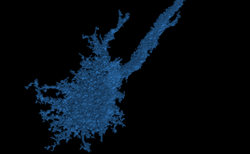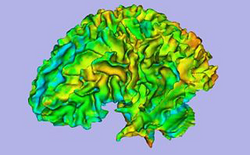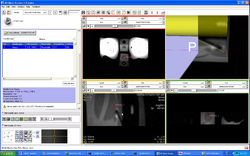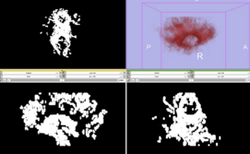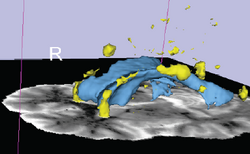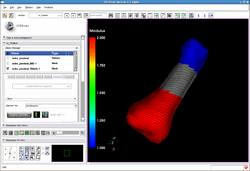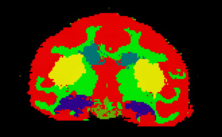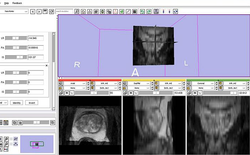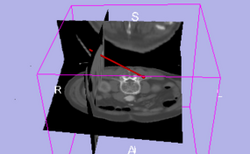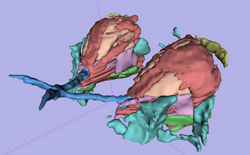Difference between revisions of "Slicer3.4:Training"
From Slicer Wiki
| Line 148: | Line 148: | ||
| style="background:#CCFF99; color:black" | [[Media:OrbiteSegmentationData.zip | Orbit Segmentation Data ]] | | style="background:#CCFF99; color:black" | [[Media:OrbiteSegmentationData.zip | Orbit Segmentation Data ]] | ||
| style="background:#CCFF99; color:black" align="Center"| [[Image:OrbitSegmentationt.png |250px]] | | style="background:#CCFF99; color:black" align="Center"| [[Image:OrbitSegmentationt.png |250px]] | ||
| + | |} | ||
| + | |||
| + | = Slicer 3.5 Tutorials= | ||
| + | |||
| + | *The following table contains "How to" tutorials with matched sample data sets. They demonstrate how to use the 3D Slicer environment (version 3.5) to accomplish certain tasks. | ||
| + | |||
| + | |||
| + | {| border="1" cellpadding="5" | ||
| + | |- style="background:#3b81a5; color:#4A2A0A; font-size:130%" align="center" | ||
| + | | style="width:8%" ;align="Center"| '''Category''' | ||
| + | | style="width:40%" ;align="Center"| '''Tutorial''' | ||
| + | | style="width:40%" ;align="Center"| '''Sample Data''' | ||
| + | | style="width:12%" ;align="Center"| '''Image''' | ||
| + | |- | ||
| + | | style="background:#FFD700; color:#4A2A0A; font-size:110%" align="Center"| <span id="1.1"></span> '''Specialized''' | ||
| + | | style="background:#FDFC6D; color:black" | '''[[Media:http://www.na-mic.org/Wiki/index.php/RobustStatisticsSegmentation | LiverSegmentation Tutorial]]''' |<br><br> This tutorial introduces translational clinical scientists to the capabilities of the 3D Slicer software through the segmentation of the abdominal |organs and vervet brain using certain robust statistics, such as the median absolute deviation(MAD) and the interquartile range (IQ), and seed points. . | ||
| + | |'''Audience''': All users and developers. | ||
| + | | style="background:#FDFC6D; color:black" | [[Media:Patient1.tar.gz | '''Robust Statistics Segmentation dataset ''']] | ||
| + | | style="background:#FDFC6D; color:black" align="Center"| [[Image:LiverSegmentation.png |250px]] | ||
|} | |} | ||
Revision as of 19:11, 1 March 2010
Home < Slicer3.4:TrainingContents
Slicer 3.4 Tutorials
- The following table contains "How to" tutorials with matched sample data sets. They demonstrate how to use the 3D Slicer environment (version 3.4) to accomplish certain tasks.
- For questions related to the Slicer3.4 Compendium, please send an e-mail to Sonia Pujol, Ph.D. (spujol at bwh.harvard.edu).
| Category | Tutorial | Sample Data | Image |
| Basic | Slicer3Minute Tutorial The Slicer3Minute tutorial is an introduction to the advanced 3D visualization capabilities of Slicer3.4. Audience: First time users. |
Slicer3Minute dataset The Slicer3Minute dataset contains an MR scan of the brain and 3D reconstructions of the anatomy |
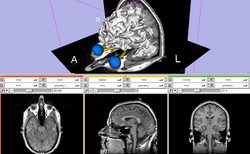
|
| Basic | Slicer3 Manual Registration Tutorial shows how to manually/interactively align two images in Slicer3.4 or 3.5 Audience: First time & early users. |
Manual Registration example dataset This dataset contains two brain MRI of a single subject, obtained in different orientations. |
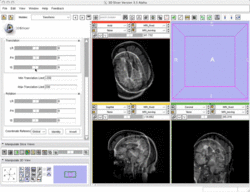
|
| Core | Slicer3Visualization Tutorial The Slicer3Visualization tutorial guides through 3D data loading and visualization in Slicer3.4. Audience: All beginning users including clinicians, scientists, engineers and programmers. |
Slicer3Visualization dataset The Slicer3VisualizationDataset contains two MR scans of the brain, a pre-computed labelmap and 3D reconstructions of the anatomy. |
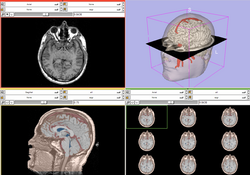
|
| Core | Programming in Slicer3 Tutorial The Programming in Slicer3 tutorial is an introduction to the the integration of stand-alone programs outside of the Slicer3 source tree. Audience: Programmers and Engineers. |
HelloWorld Plugin The HelloWorld tutorial dataset contains an MR scan of the brain and pre-computed xml and C++ files for integrating the Hello World plug-in to Slicer3. |
|
| Specialized | 3D Visualization of FreeSurfer Data The course guides through 3D visualization of FreeSurfer brain segmentations, surface reconstruction and parcellation results in Slicer3.4. Audience: All users. |
FreeSurfer Tutorial dataset The FreeSurfer dataset contains an MR scan of the brain and pre-computed FreeSurfer segmentation and cortical surface reconstructions. |
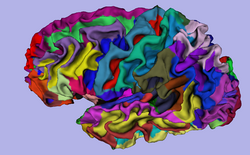
|
| Specialized | Automatic Segmentation Tutorial The course guides through the process of using the Expectation-Maximization Segmentation algorithm to automatically segment brain structures from MRI data. Audience: Programmers and Engineers. |
Automatic Segmentation dataset | 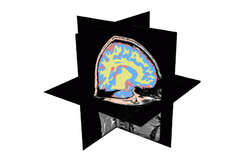
|
| Specialized | Atlas Label Merging & Surface Based Registration Tutorial This tutorial guides through the creation and co-registration of surface models of atlas structures (thalamus & thalamic nuclei) and subsequent merging of two labelmaps. |
Atlas Merging tutorial dataset (contains 2 full brain atlases + intermediate result files, 72MB) | 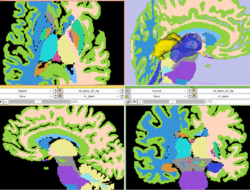
|
| Specialized | Neurosurgical Planning Tutorial This tutorial takes the trainee through a complete workup for neurosurgical patient-specific mapping. Also see this tutorial for information on how to use Slicer's affine registration, simple region growing, model maker and tractography modules. Audience: All users interested in image-guided therapy. |
Neurosurgical Planning dataset | 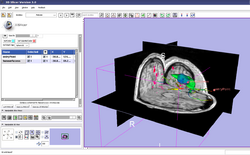
|
| Specialized | Diffusion MRI Tutorial This tutorial guides you through the process of loading diffusion MR data, estimating diffusion tensors, and performing tractography of white matter bundles. Audience: All users and developers. |
Diffusion dataset | 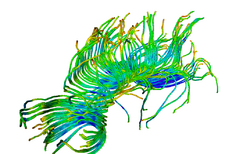
|
| Specialized | ChangeTracker Tutorial This tutorial describes the use of ChangeTracker module to detect changes in tumor volume from two MRI scans. Audience: All users interested in longitudinal analysis of pathology. |
Training data download is integrated with the ChangeTracker module (see Tutorial) | |
| Specialized | LiverSegmentation Tutorial This tutorial introduces translational clinical scientists to the capabilities of the 3D Slicer software through the segmentation of the liver. Audience: All users and developers. |
Liver Segmentation dataset | 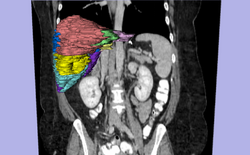
|
Slicer Tutorial Contest (under construction)
The following tutorials were part of the Summer 2009 Slicer tutorial contest and Winter 2009 Slicer tutorial contest.
Slicer 3.5 Tutorials
- The following table contains "How to" tutorials with matched sample data sets. They demonstrate how to use the 3D Slicer environment (version 3.5) to accomplish certain tasks.
| Category | Tutorial | Sample Data | Image | |
| Specialized | LiverSegmentation Tutorial | This tutorial introduces translational clinical scientists to the capabilities of the 3D Slicer software through the segmentation of the abdominal |organs and vervet brain using certain robust statistics, such as the median absolute deviation(MAD) and the interquartile range (IQ), and seed points. . |
Audience: All users and developers. | Robust Statistics Segmentation dataset | 
|
Software Installation
- The Slicer download page contains information on how to obtain a compiled version of Slicer for a variety of platforms and where to find the source code for Slicer 3.
Software Documentation
- For the Slicer 3.4 manual pages please click here. These pages are the reference manual for Slicer 3.4 and briefly explain the functionality found in panels and modules.
Older Tutorials
- Visit the Slicer 3.2 training page.
- Visit the Slicer 2 training page.
